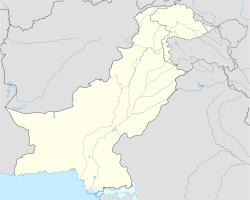
Back Multan Afrikaans ملتان Arabic ملتان ARZ मुल्तान AWA Multan Azerbaijani ملتان AZB Мултан Byelorussian Мултан Bulgarian মুলতান Bengali/Bangla Multan Catalan
Multan
ملتان | |
|---|---|
Clockwise from top: Multan Fort and the tomb of Rukn-e-Alam, Tomb of Bahauddin Zakariya, Saint Mary's Cathedral, Chenab River, Clock Tower, Qasim Gate | |
| Coordinates: 30°11′52″N 71°28′11″E / 30.19778°N 71.46972°E | |
| Country | |
| Province | |
| Division | Multan |
| District | Multan |
| Autonomous towns | 6 |
| Union council | 4 |
| Settled | 3000 BC[1] |
| Government | |
| • Type | Metropolitan Corporation[2] |
| • Mayor | None (Vacant)[3] |
| • Deputy Mayor | None (Vacant)[3] |
| Area | |
| • Metro | 560 km2 (220 sq mi) |
| Population | |
• City | 2,169,915 |
| • Rank | 6th in Pakistan 5th in Punjab |
| • Density | 7,000/km2 (20,000/sq mi) |
| Area code | 061 |
| Website | multan |
Multan[a] is the fifth-most populous city in the Punjab province of Pakistan. Located along the eastern bank of the Chenab River,[7] it is the sixth-largest city in the country; and serves as the administrative headquarters of its eponymous division and district. A major cultural, religious and economic centre of the Punjab region, Multan is one of the oldest inhabited cities of Asia, with a history stretching deep into antiquity.
Multan was part of the Achaemenid Empire of Iran in the early 6th century BC. The ancient city was besieged by Alexander the Great during the Mallian campaign.[8] Later it was conquered by the Umayyad military commander Muhammad bin Qasim in 712 CE after the conquest of Sindh.[9] In the 9th century, it became capital of the Emirate of Multan. The region came under the rule of Ghaznavids and the Delhi Sultanate in the medieval period. In 1445, it became capital of Langah Sultanate. Multan Subah was one of the largest provinces of the Mughal Empire. The Sikhs ruled over Multan from 1818 till 1849 when it was conquered by the British and made part of the British Punjab.[10]
The city was among the most important trading centres of South Asia with strong ties to Iran, Central Asia and the rest of the Persianate and Muslim world. It was a great centre of knowledge and learning in medieval South Asia during the Turkish-Persian rule,[11] and attracted a multitude of Sufi mystics in the 11th and 12th centuries, becoming a centre of spirituality in South Asia and earning the city the sobriquet "City of Saints." The city, along with the nearby city of Uch, is known for its large number of Sufi shrines dating from that era.[12]
- ^ Cite error: The named reference
multan1983was invoked but never defined (see the help page). - ^ "Every fourth district in Punjab to have a metropolitan corporation". 27 December 2019.
- ^ a b "Administrators' appointments planned as Punjab LG system dissolves today". The Nation (newspaper). 31 December 2021. Retrieved 5 January 2022.
- ^ "Punjab Portal". Archived from the original on 14 April 2006. Retrieved 17 September 2009.
- ^ Area reference Archived 14 April 2006 at the Wayback Machine, Density reference Archived 26 September 2009 at the Wayback Machine statpak.gov.pk
- ^ a b "TABLE 1 : AREA, POPULATION BY SEX, SEX RATIO, POPULATION DENSITY, URBAN POPULATION, HOUSEHOLD SIZE AND ANNUAL GROWTH RATE" (PDF). 2023. p. 6. Retrieved 9 January 2025.
- ^ Multan at the Encyclopædia Britannica
- ^ Bury, John Bagnell (2015) [1900]. A History of Greece to the Death of Alexander the Great (Digital ed.). Cambridge University Press. p. 810. ISBN 9781108082204.
- ^ Firishtah, Muḥammad Qāsim Hindū Shāh Astarābādī (1770). The History of Hindostan. T. Becket and P.A. De Hondt.
- ^ "Our History | Multan". multan.punjab.gov.pk. Archived from the original on 2 December 2024. Retrieved 30 January 2025.
- ^ Cite error: The named reference
Leviwas invoked but never defined (see the help page). - ^ Khan, Ahmad Fraz (18 January 2021). "Multan's mangoes and multinationals". DAWN.COM. Retrieved 20 January 2021.
Cite error: There are <ref group=lower-alpha> tags or {{efn}} templates on this page, but the references will not show without a {{reflist|group=lower-alpha}} template or {{notelist}} template (see the help page).
© MMXXIII Rich X Search. We shall prevail. All rights reserved. Rich X Search







